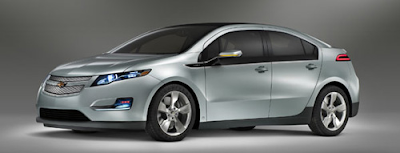As previously reported on this blog, President Obama justified the ill-advised bailout of General Motors and Chrysler by claiming that the debt-financed federal ownership of these two companies would encourage the production of "green" automobiles, like the electric-powered Chevrolet Volt pictured above. (Whether such cars really are that green is a separate question; as explained previously the manufacture of batteries for such vehicles exhibits a large carbon footprint.)
A recent study described here suggests that the bailout is just the tip of the subsidy iceburg. The study emphasizes that state-ownership of General Motors did not, in fact, suffice to encourage production of cars like the Volt. Instead, in addition to the cost of the GM bail out itself ($14 Billion), various government agencies have showered GM with Volt-related subsidies that equal between $50,000 to $250,000 per car produced. (The exact figure will depend upon whether GM satisfies certain performance criteria attached to some of the subsidies.) Even taking the more conservative estimate, i.e., $50,000 per car, the Volt, with a sticker price of $40,000, costs a total of $90,000 per car, compared to a mere $82,000 for the "Car designed by Homer Simpson," pictured above, featured in "Oh Brother Where Art Though," episode 15 of Season 2. (The episode and the car Homer designed insightfully illustrated the consequences of ignoring scarcity when making important economic decisions. The car flopped and the company making it failed. Apparently the writers did not imagine a bailout.) It seems unlikely that the benefits of the Chevy Volt justify these costs.


